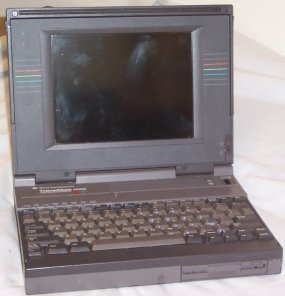 Texas Instruments made a line of laptops called "Travel Mate." Obviously, you were supposed to travel with the laptops, so they're not too heavy, and designed for travel. However, the 4000 series of laptops had a floppy disk drive in the front of the system, so you couldn't easily eject a disk with the system on your lap.
Texas Instruments made a line of laptops called "Travel Mate." Obviously, you were supposed to travel with the laptops, so they're not too heavy, and designed for travel. However, the 4000 series of laptops had a floppy disk drive in the front of the system, so you couldn't easily eject a disk with the system on your lap.
The Travel Mate 4000 series of laptops had many excellent things on it. First, they keyboard on them is the best laptop keyboard I have used. Only a keyboard such as the IBM Model M keyboard (desktop) is better. Second, many of the systems shipped with a 486WinDX2-50 CPU, Which is a 50 mHz 486 with better performance than a standard 486.
Manuals for this system can be downloaded at: http://www.acersupport.com/notebook/html/tm4000_dl.html (link broken, but left for posterity).
Parallel, serial, external monitor, modem
These are located all on the left side of the system. They do nothing special, but are standard ports. You can connect a null-modem cable to the serial ports of two systems, and transfer information.
Expansion Port
This is a long connector at the back of the system that the network adapter and other devices connect to.
Quick Port
This is located on the right side of the system, and the track ball or numeric keypad connect to it. I do not know if both will connect to the system at one time, as I do not have the numeric keypad.
The network adapter allowed access to a local area network. It has a RJ 45 jack on it, so it can connect to any standard network using the 802.3 ethernet standards. It came with its own power supply, but could use system power. There is a set of jumpers to set, and a manual to tell you how to do so. There is also a power switch, so it can be turned on and off.
This was standard with the system. Instead of an annoying track-pad, this was an actual track ball. It connected on the side of the system, tight enough to make good connection an loose enough to not break anything if it was knocked off. Using the track ball rather than a mouse takes some getting used to, but it is no where near as bad as the infernal finger pointer or track pad.
From the factory, the TI 4000e had either DOS 5 or Dos 6 on it, and Windows 3.1. There are a variety of accessories, including a network adapter. In some places, if you purchased the network adapter, you got an upgrade for Windows 3.1 to Windows for Workgroups 3.11. This allowed network support through Windows.
Software included with the system includes Drop N Go (Put icons on the Windows 3.1 desktop), a battery conservation program, laptop manager, and of course the programs that come with Dos and Windows (Qbasic, Edit, Solitare, Minesweeper...). Some of this system software can be downloaded at: http://www.acersupport.com/notebook/html/tm4000_dl.html (link broken, but left for posterity).
While the hardware in this system is capable of running Windows 95, I do not recommend it. You're in for quite a wait if you do that. Expanding the memory will help a lot, but still not give you the same performance as a Pentium would. If you wish to install a different operating system, go with something like OS/2 or Linux. (This is just my opinion.)